Menus
- Half-trail, half-roadster, automatic gearbox and trunk instead of the tank
- Discovery
- In the saddle
- Contact
- In the city
- Highway
- National
- Departmental
- Duo
- Braking
- Convenient
- Consumption
- Conclusion
Half-trail, half-roadster, automatic gearbox and trunk instead of the tank
The Aprilia Mana 850 is the real first automatic motorcycle, released by Aprilia in 2007. The visual affiliation is not unlike the Shiver 750, but more imposing. It is largely distinguished by the displacement (839cm3), the power (76 horses and 7.4 mkg of torque) but especially the sequential / automatic gearbox with transmission by variator. In short, it’s a real motorcycle, in terms of looks, engine with its V-twin, trellis frame, off-center shock absorber, ovoid headlight, chain transmission, driving position, but with the added advantage of being able to forget the passage of gears and a built-in trunk, the icing on the cake.
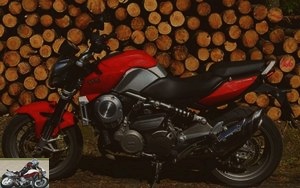
Discovery
The Mana 850 is halfway between the roadster and the trail. It looks like a roadster in terms of looks and approaches a trail in terms of driving position. We naturally notice the absence of a clutch handle but the presence of the foot selector.
Aprilia also reversed the trunk and the tank. What usually serves as a tank here is a lighted mini-safe inside, which can house a full-face helmet or a small bag plus a lock and a camera. There is even a special cell phone space and a 12V socket. The trunk opens in two ways, either via a button on the left handlebars (ignition on), or with the saddle up, using a pull tab. The tank is in fact located under the saddle, with a passenger seat that tilts..
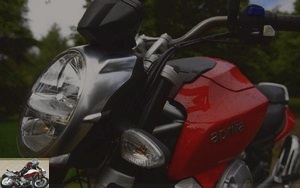
We also note the parking brake, well placed on the left of the engine, which actuates a specific caliper on the rear brake.
In the saddle
The feet really touch the ground for the 1.70 rider, despite a standard saddle set at 810mm. The position is straight and natural. The knees naturally and perfectly enclose the tank. It is more akin to the position of a trail at the triangle of feet, arms and torso than of a hairy roadster. The saddle is comfortable at first glance. We’re fine right away.

We naturally discover the speedometer and especially the huge fully digital on-board computer on the right (and we note in passing the lack of tachometer). The crutch in place is clearly indicated by a specific diagram. Totalizer, partial trip, clock, engine temperature, stopwatch, consumption. instantaneous and average, maximum speed, and especially indication of driving profile (Sport, Rain, Road, and "Manual").
The whole is surmounted by orange diodes and a red diode, to indicate the over-speed, in place of the tachometer..
In manual mode, it is in fact possible to change gears, either by the foot selector or by the two push buttons located on the left side of the handlebars. A "+" to go up the gears, a "-" to go down.
The footrests – thick and largely rubberized – are on the other hand located at the calves. They interfere with maneuvers usually carried out with the engine stopped, even if fortunately they get up quite naturally..
Contact
In the absence of a clutch handle, you must take the front brake and press the starter to start the Mana 850.

The first turns of the wheel are easy and the 215 kilos are instantly forgotten. Located in height, the impression is confirmed to be on a trail rather than a roadster. We find ourselves trying to take the clutch handle for the first few meters without it being necessary.
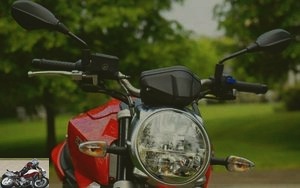
The oblong and very aesthetic mirrors are a little small to offer optimal visibility. On the other hand, they are very easy to adjust, to get the best out of them.
In the city
The lack of a clutch is confusing at first. But you actually get used to it very quickly, especially in the city with the traffic jams. We then focus on driving and looking away. Under the downpours that fell on this spring day, we tested the "Rain / Pluie" mode. And indeed, it is very sweet. Even if you turn the right grip vigorously, you can feel a delayed effect, but a crescendo in the arrival of the throttle. This effectively compares to the dimmer effect of large scooters, and in particular the shifting of gears without any sudden. Difficult in these conditions, even without habit, to cause a slip from the back. You can be tired, sick, not measuring the grip and the Mana 850 gradually accelerates smoothly. This is especially noticeable from stop to start-up; because at engaged speed, the reactions are more frank to the go-around. So much for the "Rain" mode. On the other hand, in "Sport" mode, large scooters stay behind at the green light. In less than 3 seconds you will be at over 100 km / h before you even know it. But the vibrations induced by an engine held in the towers are not very pleasant in town. In fact, it is the "Touring" mode which offers the best compromise here with clear starts and resumes, without any vibration, offering both smoothness and nervousness..
The only notable point lies in this impression of freewheeling as soon as the speed drops below 30 km / h. Flagrant in Rain mode, it is less noticeable in Sport mode, where the recovery and the engine restart more instantly.
Lightweight, the Mana 850 is very manoeuvrable in town. We just blame him for a high turning radius. Its light weight and easy handling make up for this..
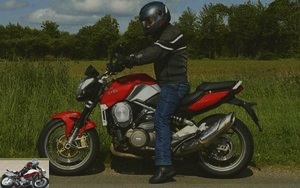
Highway
The Mana 850 sets off with vigor on the motorway. From 130 km / h, the pressure begins to be felt on the cervicals; absence of protection obliges. On the German motorway, it is possible to maintain an average of 150 km / h. At this speed, the pick-ups are still vigorous and allow a rapid climb to 170 km / h for a rapid overtaking. It is also on this diet that the head is unscrewed. On the other hand, the behavior is impeccable even in large curves..
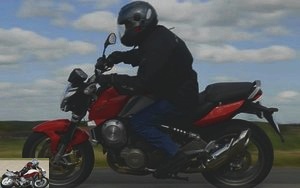
National
With its non-existent protection, the Mana 850 finds with delight the national one. We naturally forget about changing gears to alternate villages, towns and roads. Quick overtaking happens without thinking and in a natural way. You can always feel the reserve of power and the ability to accelerate at all times.
When decelerating, we also feel the engine braking, but especially in “Touring” mode. Fashion is also ideal for nationals. In fact, in "Sport" mode, you can clearly feel the vibrations of the twin, whereas they are not perceptible in "Touring" mode. The "gear changes" themselves are imperceptible, making it even more like a big scooter behavior in "Rain" mode. But it is a motorcycle, in terms of riding position, reactions and comfort.
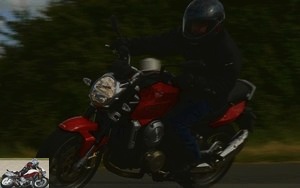
Departmental
On departmental roads, you can stay in "Touring" mode or if you’re in a playful mood, switch to "Sport" mode. The engine then stays higher in the revs longer, which is felt in the vibrations of the twin cylinder which increase significantly. However, there is no longer a lag time between pressing the right grip and the reaction of the engine, which rises much more briskly in the revs. We then find a very dynamic trail (much more than a TDM 900 in comparison, for example). Suddenly, GT driving turns into almost big roadster driving. The successions of turns are threaded quickly and dynamically.
If automatic is not enough, it is possible to switch to "manual". The 7 speeds (yes, "7") are then passed either to the selector (at the foot), or by two triggers "+" and "+" located on the left stalk. This manual mode does not prevent the Mana 850 from automatically downshifting itself if the speed is too low. So, if the Mana agrees to wind at 60 km / h in 7th, it goes down in 6th at 55km / h. Conversely, it signals that we are in the red zone, via clearly visible light diodes, which turn orange and then red. This manual mode significantly increases the engine braking.
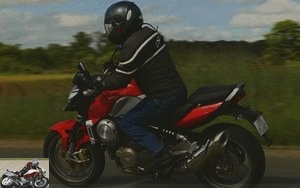
There is always the possibility of changing mode…. when driving, with a simple press on the "Gear mode" button located on the right stalk and well placed under the left pocket. We thus go from "Rain" mode to "Touring" mode then "Sport" then "Sport / Manual" and the loop continues. This loop mode explains why it cannot be possible to switch directly from "Sport" mode to "Touring" mode. But day by day, this detail is still losing its importance. Because the different modes are seldom alternated in a short period of time. And we alternate mainly between the "Touring" and "Sport" mode, from the city to the departmental.
We also note the wonderful sound of the twin and the "broops" which accompany the decelerations in "sport" mode: nice !
Duo
The Mana 850 is already high for the pilot. It is even higher for the passenger. So, if the pilot is already having trouble touching the ground, the passenger cannot afford to climb directly onto the rear footrest, and the maneuver requires a bit of gymnastics. Once placed, the position and the saddle are comfortable. The rear central handle reveals itself just a little far.
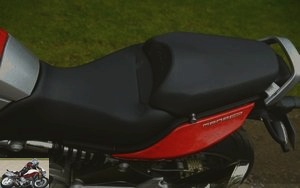
Braking
The front brake has a lot of bite but not enough feeling; the power is plenty there and can be surprising if you are not careful, especially since the front fork tends to dip under heavy braking. The rear brake sits the bike well on a curve, even if the overall feeling is a little blurry. Moreover, ABS does not easily spring into action but guarantees safety.
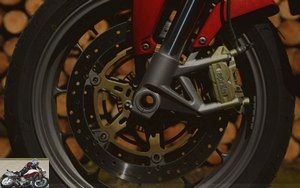
Convenient
The trunk instead of the tank is just great, especially for urban use. A standard full can be accommodated there without problem. Only a modular Schubert type – bigger than a full shoei XR1000 type – does not fit. A fortiori, we can very well put a long lock and business. And at the stop, we take out the lock, we take our things and we put the helmet instead.
Then, the lock is very easily placed between the double front brake discs.
The parking brake, available on the left, deploys very easily when you are still in the saddle and impeccably blocks the rear wheel.
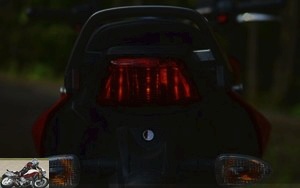
Consumption
With its 16-liter tank, the Mana 850 allows a range of 220 km before reserve, the average consumption oscillating between 5.7 and 6 liters. In fact, it all depends on the speed and the mode chosen. At 90 km / h stabilized in "Touring" mode, consumption is around 5 liters, then goes to 110 km / h at 6 liters and 130 km / h at 7 liters per hundred. Then, consumption climbs by one liter every 20 km / h following, being able to exceed 10 liters per hundred! If you really want to minimize consumption, you can also switch to manual mode, and force to be on the highest gear. Consumption at 90 km / h can then stabilize around 4.1 liters per hundred. In "Sport / arsouille" mode, consumption varies between 7 and 8 liters.
The orange reserve indicator is very visible, even in direct sunlight. A specific trip is then displayed to indicate the number of kilometers traveled since the setting on reserve. It’s not as precise as a real gas gauge (which you might expect) but there is still 4 liters of range left, enough to cover 60 kilometers at a moderate pace.
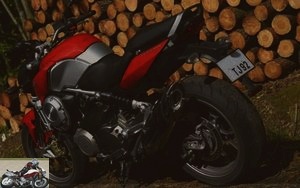
Conclusion
Versatility is the key word that comes to mind to characterize the Aprilia Mana 850. With its automatic mode and its trunk, it becomes ideal for peri-urban use and for the biker who wants a little comfort, ease and ease of movement between the lines. Arrived at the weekend, it turns into a real motorcycle – in sport or manual mode – to literally investigate the small roads. Those who want to travel far will add a high bubble, essential to consider motorway journeys. The “Rain” mode is ideal for Monday mornings with flu in the rain. The "Sport" mode is ideal for Arsouilles. The "Touring" mode turns out to be the most versatile and most in tune with the soul of the machine. At 9,399 euros (9,999 euros with ABS), the Mana 850 is also well placed on the price niche. It remains to convince the bikers of the negative a priori on the motomatic. The Mana 850 proves that these a priori are unfounded and on the contrary leave room for real sensations.
Strong points
- Versatility
- Automatic box
- Easy to use
- Practical aspects
Weak points
- Saddle height
- Turning radius
Competitors: Yamaha TDM 900
The opinions on the motorcycle guide
Datasheet
Related articles
-
BMW GS 1250 motorcycle test daily
Flat Twin ShiftCam of 1,254 cm3, 136 hp and 143 Nm, 249 kg full made, from 17,599 euros Daily test for 15 days Already more than 800,000 big GS sold in…
-
Honda NC 700 S motorcycle test
Crisis solution Honda revives the basic motorcycle with its NC 700 S: a floor price, practical aspects borrowed from the scooter and consumption at the…
-
Triumph Tiger 1050 motorcycle test
A 4-day trial over 1,100 km The Triumph Tiger had taken a sacred look of old over the years, especially compared to the new Varadero and VStrom, despite…
-
Honda Hornet 600 – CB600F 2007 vintage motorcycle test
Ten-day test of the 2007 vintage Exit on the heels of the wicked roadsters ago more than 9 years, the CB600F Hornet has been completely revised in 2007….
-
Aprilia Shiver 750 SL motorcycle test
2008 vintage The Shiver is Aprilia’s big novelty in the villainous 750 cc roadster segment in 2007. It quickly evolved in 2008 with 3 handlebar behavior…
-
Roadster with Sugomi sauce or decarenated sports car A2 licenses have the choice between large bridles, sometimes very badly bridled, and smaller ones,…
-
Triumph Daytona 675 motorcycle test
After several sports trials 4 cylinders in 600 cm3 (TT 600 then Daytona 600), Triumph gives up to reveal finally a sports 600 based on a 3 cylinder: the…
-
Triumph Speed Triple 955i motorcycle test
Warning ! Nasty roadster ! Is it necessary to present the Speed Triple? Jewel of the English brand, the big three legs roadster is present in all the…
-
Suzuki Bandit 1250 S ABS motorcycle test
If you’re looking for a tiger in an engine, roar a Bandit 1250 The presentations are really no longer to do but, with this version equipped with a fork…
-
Suzuki Bandit 1250 N GSF motorcycle test
The Suzuki Bandit 1250 is the evolution of the Bandit 1200, the big historic roadster unveiled in 1995, having hit sales not only for its puncture-proof…
Hello,
Another great article, always clear and explanatory.
The design is broken, ok.
Is she ugly? you still have to see it first hand, no ?
So wait until June to try it and you can judge it …